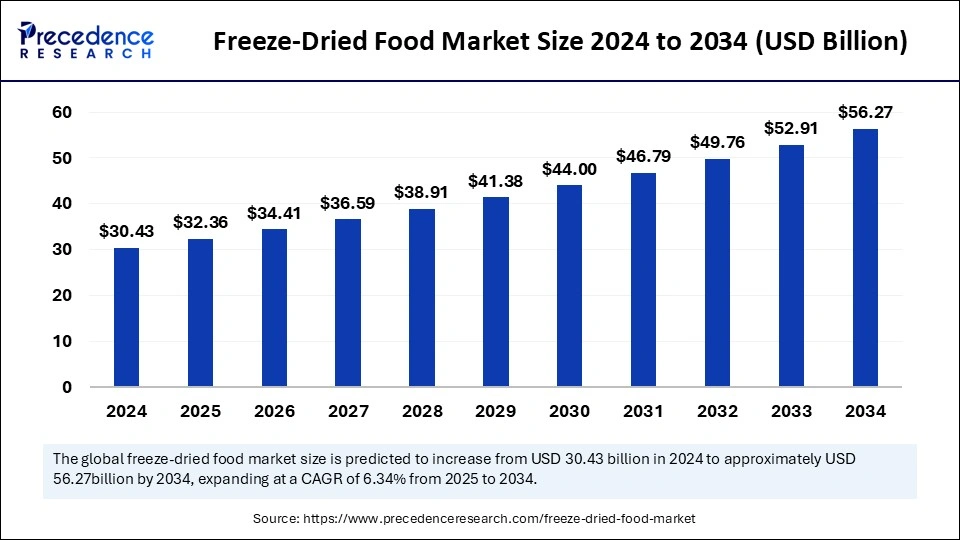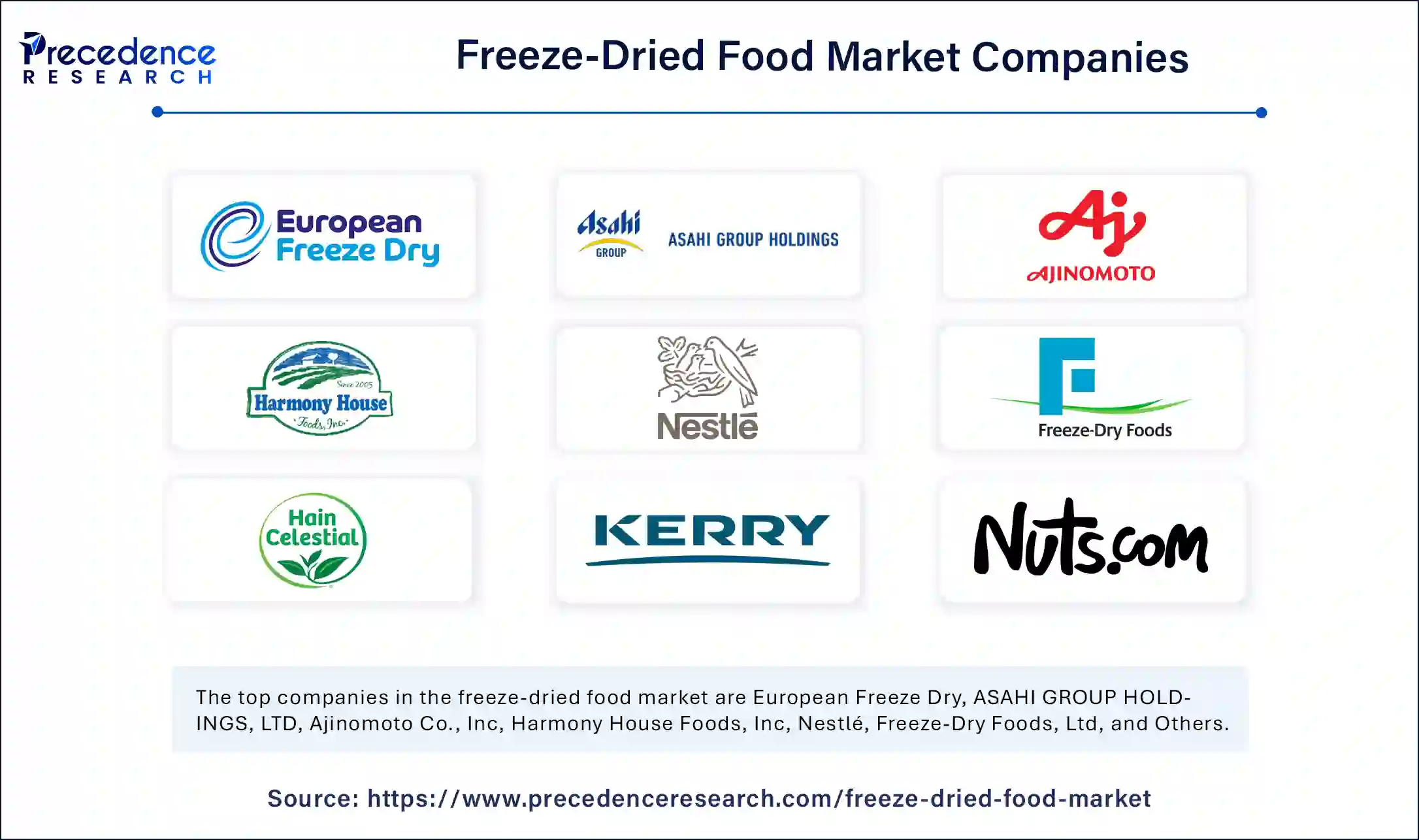January 2025
The global freeze-dried food market size is calculated at USD 32.36 billion in 2025 and is forecasted to reach around USD 56.27 billion by 2034, accelerating at a CAGR of 6.34% from 2025 to 2034. The market sizing and forecasts are revenue-based (USD Million/Billion), with 2024 as the base year.
The global freeze-dried food market size accounted for USD 30.43 billion in 2024 and is predicted to increase from USD 32.36 billion in 2025 to approximately USD 56.27 billion by 2034, expanding at a CAGR of 6.34% from 2025 to 2034. The freeze-dried food market continues to expand due to a surge in customer need for easy-to-use sustainable meal options with durable shelf life and preserved nutrients.

Introducing artificial intelligence (AI) systems into freeze-dried food manufacturing helps to optimize drying operations while improving final product quality and production process efficiency. The ability of AI algorithms to operate across extensive sensor data to create predictions regarding optimal drying parameters, including temperature, pressure, and time duration for achieving the best possible freeze-drying results.
The real-time parameter management of AI systems increases the process yield through reduced product loss while decreasing energy consumption, thus improving economic viability and sustainability. Through AI integration, manufacturers can boost their product innovation capacity through its ability to assist with creating new food varieties and formulations and technical advancements that enhance the development of the freeze-dried food market.
The drying process applied in the freeze-dried food market first freezes then vacuuming away water molecules which creates lightweight stable items available for long-term use. These products exist in multiple groups such as complete meals, snacks, smoothies, cereals, and baked goods, which fulfill diverse dietary requirements. Freeze-dried foods attract consumers due to their simple cooking setup, portability, and ability to store for extended periods.
The growing interest in camping, hiking, and mountaineering activities led to a stronger demand for freeze-dried foods since these foods offer both better storage capabilities and ease of use. The emergency food market needs combinations of convenience and weight reduction, nutritional value, portability, and emergency-ready capabilities. Freeze-dried food product markets expand because emergency preparedness supplies continue to increase in disaster-prone areas. The freeze-dried product market attracts more customers by introducing innovative product choices containing new flavor profiles and nutritional content.
| Report Coverage | Details |
| Market Size by 2034 | USD 56.27 Billion |
| Market Size in 2025 | USD 32.36 Billion |
| Market Size in 2024 | USD 30.43 Billion |
| Market Growth Rate from 2025 to 2034 | CAGR of 6.34% |
| Dominated Region | Asia Pacific |
| Fastest Growing Market | North America |
| Base Year | 2024 |
| Forecast Period | 2025 to 2034 |
| Segments Covered | Product, distribution channel, and Regions |
| Regions Covered | North America, Europe, Asia-Pacific, Latin America and Middle East & Africa |
Growing demand for natural flavor
The market for natural food flavors has grown rapidly because customers value health-oriented choices and avoid artificial flavors and sweeteners. Customers who want real-tasting natural flavors force the food industry to create different forms of freeze-dried fruits such as granulates, slices, chips, and powders. The freeze-dried food market delivers whole-label natural products that provide substitute choices for artificial food ingredients. Freeze-dried foods have become more popular among consumers because they recognize the risks artificial ingredients pose to their health. The market trend toward freeze-dried fruits continues to grow because these products offer numerous flavors and ethical sourcing of natural ingredients that match contemporary consumer demands.
Rising demand for convenience food
Consumer income growth in emerging markets drives the rising market need for frozen convenience foods. Freeze-dried food market products gain more popularity because they provide quick preparation time alongside long shelf life, protect original tastes, and maintain their nutritional value. Freeze-dried foods provide city residents with an excellent eating solution since these easy-to-use products skip lengthy preparation steps. The market responds to increasing demand by adding new products that include spawning tropical and exotic fruits with berries, citrus, and orchard varieties. The market presently demonstrates a transition toward swapping synthetic flavors and colors with natural versions, which supports the increasing clean-label product requirements.
High cost of freeze-drying equipment and processing
High expenses related to freeze-drying equipment and processing costs act as significant obstacles to the expansion of the freeze-dried food industry. The combination of freeze-drying devices and advanced infrastructure demands, together with storage facilities, generates substantial financial barriers that prevent small to medium-sized enterprises (SMEs) from competing in this market. Freeze-drying equipment requires large amounts of power consumption and necessary periodic maintenance activities that lead to increased operational expenditures.
The expense increases through maintaining controlled product environments for quality control purposes. Processing freeze-dried products requires specialized labor, which companies need to hire and keep at affordable costs. The freeze-drying process degrades specific nutrients, including vitamin C, until the end product develops an altered nutritional value.
Clean-label freeze-dried food products
Freeze-dried food market growth depends strongly on rising consumer favor of products with natural labels. The market demands transparent natural food with minimal processing because health-conscious customers examine their ingredients. The freeze-drying process achieves consumer demand by providing products with extended shelf stability as well as convenient nutrition, natural flavors, and preservative-free and additive-free solutions.
The clean-label trend urges manufacturers to produce novel freeze-dried food products that fulfill consumer requirements for health and ingredient transparency. The natural fit of freeze-dried foods with clean-label criteria depends on their minimal processing needs, and therefore, market demand for natural food choices will drive their adoption as manufacturers develop fresh opportunities.
The vegetable segment donated the largest freeze-dried food market share in 2024. The worldwide market demands freeze-dried vegetables, which include broccoli, carrots, green beans, sweet corn, peas, and mushrooms. Commercial entities such as restaurants, hotels, and food courts strongly demand freeze-dried vegetables to buy bulk products because of their ease of access.
The food industry utilizes these vegetables frequently for fast food manufacturing and the preparation of instant dishes, as well as for seasoning various dishes. Dried vegetable products in freezer form, including beans, corn, peas, tomatoes, and onions, appear in sauces, salads, chutneys, meat sausages, and breakfast foods. Food service operations depend on freeze-dried vegetables because they preserve flavor as well as color and nutrition without requiring refrigeration.
The fruit segment is anticipated to show considerable growth over the forecast period. The market prefers freeze-dried fruits such as apples, bananas, strawberries, mangoes, and pineapples since these products offer extended shelf life and simple storage methods alongside enhanced usability.
Frozen dried fruits represent a nutritious food choice for people who care about their diets because they maintain both their real taste and their fundamental dietary components. People can experience fresh fruits throughout each year while maintaining seasonality availability thanks to freeze-drying manufacturing. Market growth for freeze-dried fruits will increase because consumers show a growing interest in healthy eating alongside natural food products.
The B2B segment held the dominating share of the freeze-dried food market in 2024. Freeze-dried ingredients remain valued by food and beverage manufacturers and the nutraceutical industry, along with specialists in bakery products, because they protect original taste attributes, nutritive elements, and visual characteristics during vacuum freeze-drying operations. The manufacturing industry selects freeze-dried products for developing ready-to-eat meals because they can also serve in snack products, cereals, soup mixtures, sauces, and health supplements and can even create pet food.
The business-to-business sector demonstrates expansion through product development that targets client demands for preserved and healthful convenient food products. Contemporary food manufacturing companies depend on the B2B market segment to maintain their position as significant contributors to the freeze-dried food business.
The B2C segment is anticipated to show considerable growth over the forecast period. The market continues to expand due to rising customer interest in ready-made food that supports nutritional health. Different retail channels, such as supermarkets, convenience stores, and online retail platforms, simplify the shopping process for consumers to buy freeze-dried fruits, vegetables, and regular shopping items.
Small groceries and supermarkets enable simple product purchasing through convenient locations and the advantage of online home delivery systems that increase buyer convenience. Online retail channels will significantly boost the growth of the B2C market segment by offering quick and simple buying procedures that provide consumers with easy access to their freeze-dried purchases.
Asia Pacific accounted for the largest share of the freeze-dried food market in 2024. Advancements in urban consumption practices led people to choose packaged food more often, and they increasingly select freeze-dried products among other processed food choices. The market shows a rising demand for diverse freeze-dried products due to differing consumer tastes that exist between China, India, Japan, South Korea, and Australia. Freeze-drying technology operates more affordably because food processors developed their methods while Asia-Pacific residents generate larger disposable funds.
Chinese market growth results from urbanization and citizens choosing convenient ways of living. As Asian per capita income grows and their middle-class customer base there exists steady growth in packaged ready-to-eat freeze-dried food consumption.
North America is anticipated to witness the fastest growth in the freeze-dried food market during the forecasted years. The market demands both healthy and convenient food options as its primary driver. The dominant market position of the United States reveals growing consumer interest in organic food products because people focus on dietary health. Freeze-dried foods have become more popular for outdoor activities such as hiking and camping since they offer lightweight, stable meals.
Freeze-dried food consumption is most prominent in the United States. Freeze-dried foods gained popularity because they offer easy-to-use and long-term storage alongside the preservation of essential nutrients. The North American market remains under U.S. control because of health-conscious consumers, evolving retail systems, and rising demands for nutritious food.
The European freeze-dried food market has been growing at a notable rate in recent years as consumers increasingly seek convenient nutritious food products. The region stands ready to handle shifting market needs because it maintains well-established food processing operations and advanced research development capabilities. Freeze-dried food products with organic and clean-label status have gained popularity among European consumers because they prioritize their wellness and health needs. European consumers enjoy enhanced market power through the combination of superior food processing plants and distribution networks maintained by Germany, thereby simplifying European-wide shipments.

By product
By distribution channel
By Region
For inquiries regarding discounts, bulk purchases, or customization requests, please contact us at sales@precedenceresearch.com
No cookie-cutter, only authentic analysis – take the 1st step to become a Precedence Research client
January 2025
April 2025
September 2024
January 2025